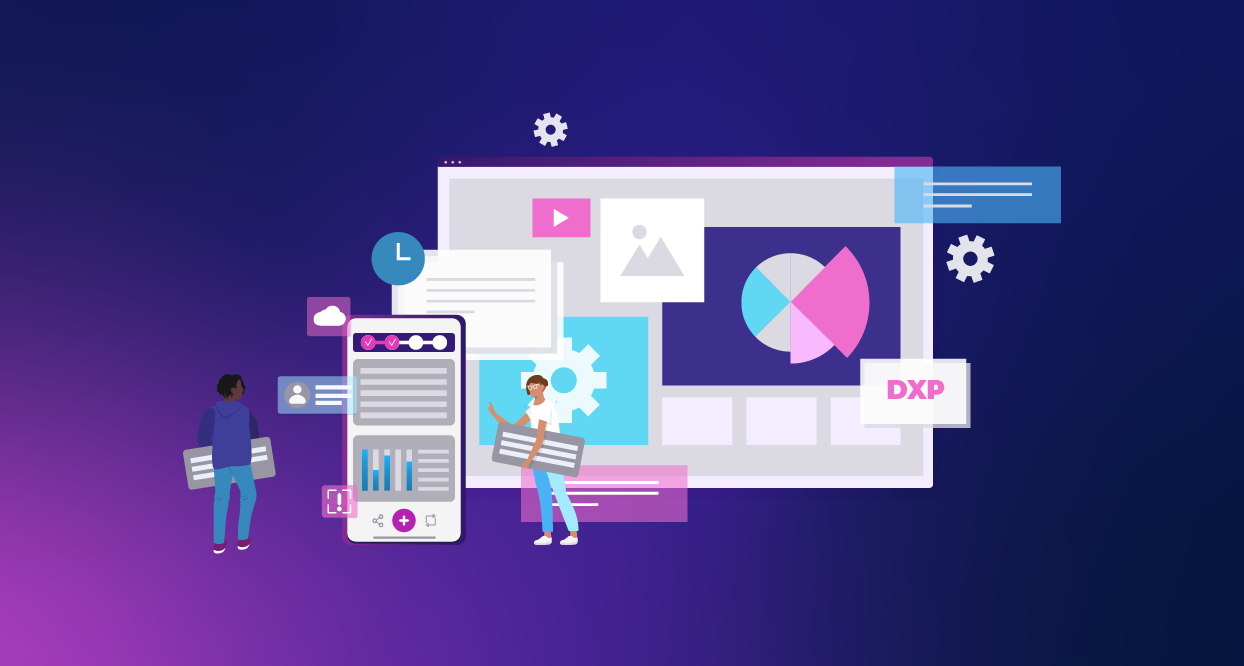Crafting Seamless Experiences: The DXP Advantage

Providing exceptional and personalized user experiences has become a cornerstone of success for businesses. Mere functionality is no longer enough to engage users. Instead, it's all about experiences that resonate on a personal level and leave a lasting impact.
To meet the growing demands of customers and stay ahead of the competition, organizations continue to turn to Digital Experience Platforms (DXPs). According to Gartner, the DXP market grew by 14.9% to $3.7 billion in 2022. This double-digit growth indicates that DXPs are becoming increasingly integral in delivering highly-contextualized customer experience journeys. We continue to see DXPs as the platform most often selected by clients in pursuit of digital transformation. DXPs are considered by organizations for a variety of reasons, including their impact on enhancing customer engagement, streamlining operations, and driving business growth.
Decoding DXPs: What They Are and Why They Matter
A DXP is a suite of integrated technologies that empowers organizations to deliver consistent, engaging, and personalized digital experiences across various touchpoints.
A DXP is not merely a collection of standalone tools or software solutions—it's an integrated platform that offers a holistic approach to managing, delivering, and optimizing digital experiences through a unified framework. It goes beyond simple content management by encompassing features like content delivery, customer data management, analytics, and more.
A DXP is a good fit for organizations when they have specific needs related to managing and delivering digital experiences across various channels, devices and touchpoints. It facilitates commitment to staying ahead of the curve, anticipating trends, and adapting to the ever-changing needs of customers.
With the increased prevalence of composable solutions, it’s important to remember that DXPs can also integrate with other platforms, creating a seamless ecosystem that allows different systems to share data and communicate.
We work with many DXP solutions including industry leading platforms such as Adobe, Acquia and Salesforce, and our team has extensive experience integrating various tools and even developing APIs for custom integration to craft unique digital experience strategies for each of our clients.
Unleash the Power: Key Features of DXPs
A DXP brings together a range of capabilities that enables organizations to excel in today’s digital landscape. From content management capabilities to data-driven insights that unveil profound user behavior patterns, DXPs provides the architecture needed to support omnichannel delivery.
Content Management
DXPs offer robust content management capabilities, allowing businesses to create, curate, and deliver content across various channels while ensuring consistency and personalization. Content management is the foundation for developing digital strategies that are engaging and effective, so it’s important to make sure you consider the right solution for your goals.
Data Integration
One of the core strengths of a DXP is its ability to integrate customer data from various sources, enabling businesses to create personalized experiences based on user behavior and preferences. With built-in analytics tools, DXPs empower organizations to gather actionable insights into user behavior, enabling continuous improvement of digital experiences.
Multi-Channel Delivery
DXPs support seamless content delivery, ensuring that content is optimized for various devices and touchpoints, and provide a consistent experience to users regardless of the platform used. We hear a lot about omnichannel customer experience from our clients and one of the key strategies in developing digital experience programs is to focus on the integrated brand experience rather than a specific exchange.
Positioning DXPs: Their Unique Role in Today’s Digital Ecosystem
It's important to differentiate between DXPs and other platforms like Content Management Systems (CMS) and Customer Data Platforms (CDP).
While both CMSs and DXPs handle content, a CMS focuses primarily on content creation, editing, and publication, offering basic content management features without the advanced capabilities for tailored user interactions and omnichannel engagement that a DXP provides. In contrast, a DXP offers a comprehensive suite of tools for creating, delivering, and optimizing personalized and contextually rich digital experiences across channels, involving features like personalization engines, customer data management, analytics, and integrated marketing tools. Smaller businesses or those with simpler digital experience requirements may find that a CMS or other specialized tools are more cost-effective and appropriate.
While CDPs and DXPs often complement each other, a CDP is geared towards aggregating and managing customer data to create a comprehensive and holistic view of each customer. A DXP goes further by using this data to create seamless, engaging experiences across multiple touchpoints.
In many cases, organizations benefit from combining the strengths of DXPs and CDPs. A DXP can leverage customer data from a CDP to create highly personalized, context-aware digital experiences. To learn more about how Bounteous leverages data to provide the best customer experiences, check out our deep dive on CDPs.
Stepping Up with DXPs: Unraveling the Benefits
Adopting a DXP can empower organizations in several ways and transform a brand’s digital presence. Providing a unified ecosystem, delivering personalization at scale and enabling vendor integration are just three of the top advantages we see with our client programs.
DXPs integrate content management, commerce, personalization, and analytics capabilities into a single platform, enabling organizations to streamline their digital presence, enhance customer interactions, and accelerate time-to-market for new digital initiatives.
A DXP's integrated nature eliminates data silos and enhances collaboration between different departments, resulting in consistent and coherent digital experiences. They provide access to comprehensive customer data, allowing companies to deliver tailored experiences, which enhance engagement and loyalty.
DXPs can also integrate with various third-party tools and systems, helping you connect different aspects of your business ecosystem and providing a holistic view of your operations – including data and content synchronization, single sign-on, and streamline workflows.
Both Gartner and Forrester report that embracing these solutions can lead to improved customer satisfaction, higher engagement rates, better data-driven insights, and ultimately, a competitive edge.
The Practical Side: How DXPs Compare With Build vs. Buy
The value that is created from these DXPs increases as companies take advantage of native integrations and leverage the capabilities of complementary product suites. Using some or part of a DXP can absolutely deliver value, but companies will understand the ‘why’ the more they lean in.
There are certain tradeoffs that come with this. Some companies prefer more customization than might be available or would prefer to swap certain products for ones they’ve already purchased. This may not be as easy with a DXP as it is with fully customized solutions. Every solution requires a certain amount of customization, but there are certainly advantages to using products that are part of a larger ecosystem and are optimized to work together.
Education and Support
Large companies that leverage DXPs may have better support opportunities including proprietary training or specialized learning courses that aren’t available to the public. Within these large systems of support, if you encounter difficulties, there are often experts or contractors you can rely on to share best practices, track down documentation references or even provide individual guidance. With custom solutions, individual team members may need to be more responsible for creating processes from the ground up and may leverage communities, forums, or open source platforms to help troubleshoot along the way.
Resource Availability
When thinking through hiring needs, it’s important to take into consideration the different skill sets you’re targeting. A well-established platform or more popular product could indicate a larger talent pool of qualified candidates. Many DXPs have developers that specialize in the specific platforms and have done similar projects using these exact tools previously, while custom development work might be more unique and require highly specific expertise to help run and operate the set of tools.
Continuous Improvements & Features
Many digital experience platform companies are incentivized to keep their customers happy and attract new customers by providing continuous value. Bigger platforms mean greater investments in research and development, leading to more frequent improvements and product updates to ensure they are at the forefront of digital innovation.
Launch with Precision: The Blueprint for DXP Success
Launching a DXP requires careful planning and execution. First, we recommend a thorough assessment of your organization's digital goals and customer needs. Truly understanding your audience and tailoring the platform to meet their needs and preferences is key to a successful implementation.
It is essential to align the DXP's capabilities with your objectives. Consider prioritizing existing tools and systems if there’s already organizational alignment and buy-in.
A well-defined content strategy that accounts for personalization, consistency, and scalability should be implemented. It’s also important to keep in mind budget allocation and team training to ensure all key stakeholders can really maximize the platform’s potential as well as continual team feedback to make necessary adjustments and improvements along the way.
Beyond the Hype: The Enduring Impact of DXPs
DXPs continue to be the primary solution to help brands meet the evolving needs of customers. They are reshaping the way businesses engage with their audiences through a comprehensive suite of capabilities, seamless integrations, and personalized experiences.
By embracing an integrated ecosystem, organizations can adopt innovation and unlock new levels of efficiency, engagement, and growth. A successful DXP launch is not the end of the journey—it’s the beginning of an ongoing effort to continuously improve and optimize the digital experiences you deliver to customers and users.


